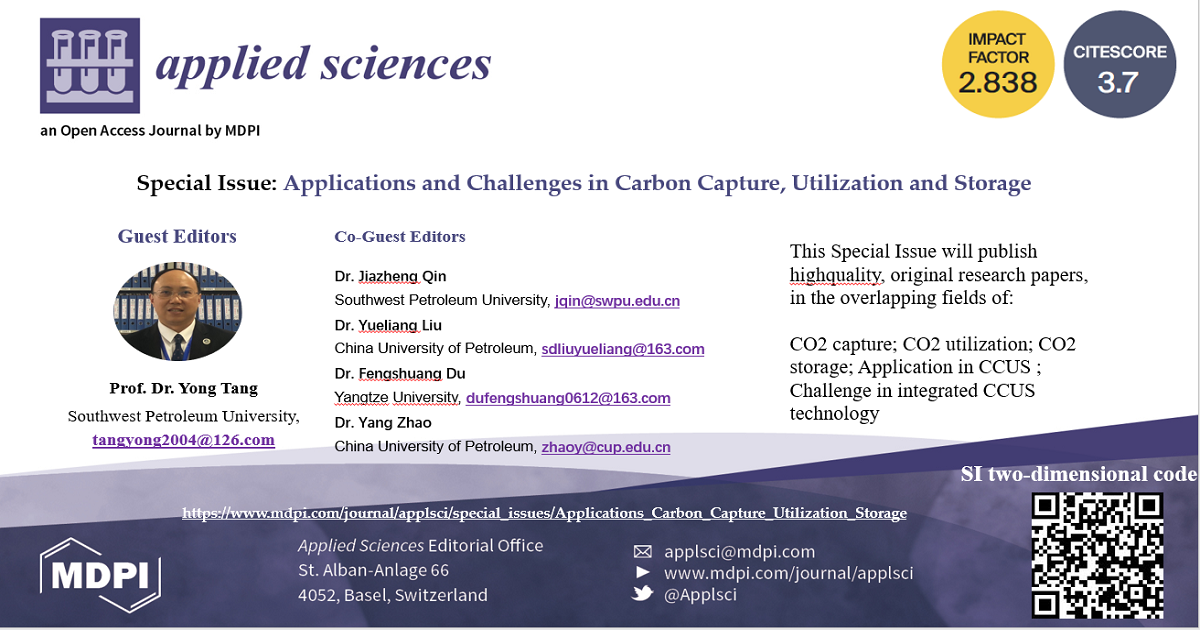Applications and Challenges in Carbon Capture, Utilization and Storage
A special issue of Applied Sciences (ISSN 2076-3417). This special issue belongs to the section "Energy Science and Technology".
Deadline for manuscript submissions: closed (20 December 2023) | Viewed by 13295

Special Issue Editors
Interests: CO2-EOR; CO2 storage; application in CCUS
Interests: CO2 capture; CO2 storage; challenge in integrated CCUS
Interests: CO2 storage and utilization; CO2 fracturing
Special Issues, Collections and Topics in MDPI journals
Interests: CO2-EOR, CO2 storage, CO2 utilization
Special Issue Information
Dear Colleagues,
Carbon Capture, Utilization and Storage (CCUS) refers to a suite of technologies that can play an important and diverse role in meeting global energy and climate goals. The global demand for CCUS market is mainly driven by growing focus on reducing CO2 emissions, supporting government initiatives, and increasing demand for CO2-EOR techniques.
CCUS schemes can be classified by their capacity and permanence of storage, environmental consequences, and cost of implementation. Any viable system for storing carbon must be effective and cost competitive, stable as long-term storage, and environmentally benign.
The challenges in scaling the industry, as with most industries, lie primarily in the cost of developing and operating the necessary infrastructure. Technical innovation through improved capture technologies and modelling of transport and storage will be important in mitigating these costs. Various scientific, economic, and societal aspects need to be addressed to ensure successful development and implementation of CCUS technologies.
This Special Issue will publish high-quality, original research papers, in the overlapping fields of:
- CO2 capture (pre-combustion, oxy-fuel combustion, post-combustion, chemical looping combustion, etc.);
- CO2 utilization (CO2 flooding, CO2-foam flooding, CO2 huff-n-puff, CO2 fracturing, CO2 thickener, etc.);
- CO2 storage (CO2-water-rock reaction, CO2/hydrocarbon phase behaviors, storage capability prediction, CO2 leakage, etc.);
- Application in CCUS (CCUS pilot tests, demonstration projects, etc.);
- Challenge in integrated CCUS technology (implementation strategies, environmental impacts, economics, risk assessment, etc.).
Prof. Dr. Yong Tang
Dr. Jiazheng Qin
Dr. Yueliang Liu
Dr. Fengshuang Du
Dr. Yang Zhao
Guest Editors
Manuscript Submission Information
Manuscripts should be submitted online at www.mdpi.com by registering and logging in to this website. Once you are registered, click here to go to the submission form. Manuscripts can be submitted until the deadline. All submissions that pass pre-check are peer-reviewed. Accepted papers will be published continuously in the journal (as soon as accepted) and will be listed together on the special issue website. Research articles, review articles as well as short communications are invited. For planned papers, a title and short abstract (about 100 words) can be sent to the Editorial Office for announcement on this website.
Submitted manuscripts should not have been published previously, nor be under consideration for publication elsewhere (except conference proceedings papers). All manuscripts are thoroughly refereed through a single-blind peer-review process. A guide for authors and other relevant information for submission of manuscripts is available on the Instructions for Authors page. Applied Sciences is an international peer-reviewed open access semimonthly journal published by MDPI.
Please visit the Instructions for Authors page before submitting a manuscript. The Article Processing Charge (APC) for publication in this open access journal is 2400 CHF (Swiss Francs). Submitted papers should be well formatted and use good English. Authors may use MDPI's English editing service prior to publication or during author revisions.
Keywords
- CO2 capture
- CO2-EOR
- CO2 storage
- application in CCUS
- challenge in integrated CCUS






